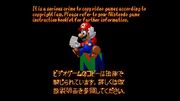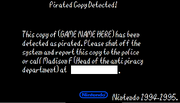
A picture of the Anti-Piracy Screen
The Anti-Piracy Screen is a normally unused screen from Super Mario 64 that was supposed to be shown when an individual plays a pirated copy of the game. In the base game, this screen is disabled from appearing in the game, regardless of what type of copy of it is. The screen itself has Mario sitting on the Nintendo 64 logo looking at a Nintendo 64 game cartridge with a distraught expression. The model of Mario is not the one in the game, meaning that this screen was pre-rendered.
The text on the screen in English and Japanese states that it is serious crime to pirate any video game according to copyright law, and that the person who's looking at the screen must refer to their Nintendo 64 game instruction booklet regarding more information regarding pirated copies of Nintendo 64 game cartridges.

Super Mario 64 Piracy Protection
The first known sighting of the Anti-Piracy Screen came from the YouTube channel Super Mario 64 Beta Archive, where in the video the youtuber finds the anti piracy screen in an old copy of Super Mario 64 that they received from their friend. It is possible that this cartridge was a pirated cartridge, but it seems to be rather unlikely.
Theories[]
It is possible that piracy detection in the earlier versions of the Nintendo 64 had the same mechanics used with both the NES and SNES, with the CIC lockout chip being used for cartridges and consoles to verify that the copy of the game is not a pirated one. With this possibility, the Anti-Piracy screen in Super Mario 64 was probably created to show detection of a pirated copy when the Nintendo 64 had different anti piracy measures then it does now.
As to why it could have been scrapped, the final versions of the Nintendo 64 contains a modified version of the CIC lockout chip that uses a checksum to detect if a cartridge is pirated or not. If the checksum finds the cartridge to be pirated, the game would not turn on. This would render the need for a detection screen pointless so it was scrapped.
It is also possible, since there are several different CIC lockout chips that a given game might have on its cartridges, that this screen may have been intended for when a valid-but-unexpected CIC chip is detected. This is not without cause, as a number of games (including but not limited to Yoshi's Story and Jet Force Gemini) have used this type of piracy check which polls the system's PIF to check which particular CIC chip is present on the cartridge, though these cases generally take the "impaired game experience" approach instead of a simple warning screen. If this truly is what Super Mario 64's warning screen was intended for, then a decision to use the above-mentioned approach might be why it's unused. However, this is merely speculation, as that technique is also not known to be present in the game.
How the Anti-Piracy Screen was discovered could be as a result of an error caused by the Personalization A.I enabling the screen to be featured, particularly via The Self-Patching Anomaly. This anomaly could have enabled the piracy screen to be enabled on any potential cartridge of Super Mario 64 as a malfunction.
Reports[]
Report 1:
"So, I was in my house. I was going to play some super mario 64. I booted up the game and the norm happened at first. But when I loaded my save file and went into bob-omb battlefield, this anti-piracy screen showed up. It looked like mario was about to cry on a n64 logo. The bottom of the screen had japanese text that I of course didn't understand. I bought a new copy of the game after this occurrence, but I haven't played super mario 64 since."
Report 2:
"I found this screen when I was about to go into the final bowser level. I jumped into the warp and for some reason, a star select screen showed up. All stars were collected and all the stars were named "There is nothing you can do". I selected a random one and this screen showed up. A eyeless, sad mario head with blue japanese text is the appearance of this screen. After that the game crashed and I haven't been able to play this copy since because the game blacks out if I try to boot it up."

Report 3:
"Hello. My name is Madison. I used to work at Nintendo, in the anti-piracy department. In 1995, I worked on the anti-piracy tools of the Nintendo 64 and we created a default piracy detection screen for it. To my knowledge I don't think that it was used for anything else other than Super Mario 64. I included a screen-grab of the screen with this email."
